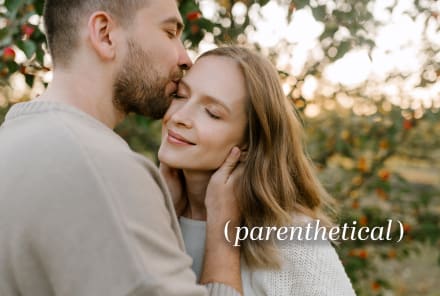Advertisement
The 4 Points Of Balance For Holding On To Yourself In Relationships


When I work with couples, I'm often listening to their position within the relationship, and how they pull, provoke, or push one another off balance. Attachment is a dance, and the coordination that is required for enjoyable dancing is first and foremost an awareness of one's own dance steps and secondly an awareness of how your partner dances.
Healthy relating doesn't work if one partner says, "I'll just do your dance steps." Connected partnership also doesn't sound like, "Just dance like I dance." Conscious partnership also isn't, "I'll dance over here, and you dance over there."
Balancing autonomy and attachment.
One of the core ways that we engage in relationships is by finding a balance between our need for connection and our need for separateness. A relationship where two people are enmeshed and share every aspect of life with each other isn't a healthy relationship, nor is a relationship with so much distance that people don't share anything with each other.
Too much closeness results in emotional symbiosis: when a person isn't able to comprehend another person's subjectivity and separateness. Emotional symbiosis, engulfment, merging, or fusion are all terms used to describe this relational phenomenon. Too much distance, on the other hand, can result in conflict, estrangement, loneliness, or what's sometimes known as invisible divorce, a term used to refer to a couple who is still legally married but no longer have romantic feelings for or intimacy with each other. There may be deep feelings of negativity, relationship trauma, and long-standing patterns of disconnection.
Just like with diet, exercise, work, and play, the most sustainable and healthy position in partnership is a balancing point between connection and separateness. However, this balance isn't an easy task between two people, mainly because partners often need different things when it comes to attachment. Balance requires awareness and intention, and without communication about needs and explicit negotiation of differences, couples often feel unbalanced.
As licensed clinical psychologist and couples therapist David Schnarch, Ph.D., writes in his book The Passionate Marriage, "Giving up your individuality to be together is as defeating in the long run as giving up your relationship to maintain your individuality. Either way, you end up being less of a person with less of a relationship."
The two central drives for human beings are autonomy (control of our individuality) and attachment (urge for relationship). Healthy maturation means that we are able to achieve both of these and balance them in our lives.
The ability to balance our needs for autonomy and attachment is called differentiation. Differentiation is a biological process that occurs in all species. For humans, it is about becoming more of an individual and a solid person through relationships with others. It is the ability to separate ourselves from others. Differentiation allows us to feel our own subjective reality—bodies, emotions, and thoughts—as separate from another person while being in relationship with another person.
What happens when we're off balance.
When entering into a relationship, it is not uncommon for some people to fear being engulfed, intruded upon, or controlled by another person. This style of relating is a result of early attachment, and often these individuals may display "distancing" behaviors or styles. You may recognize this style as an "avoidant" attachment style.
Other people may enter relationships with the fear of being abandoned or not receiving the commitment they need in order to feel safe and secure. This style is also a result of early development attachment and may result in "pursuer" behavior. You may recognize this style of relating as an "anxious" attachment style.
What is important to consider is that, for many people, they experienced both abandonment and intrusion in early development, and so their adult attachment experience may alternate between needing distance and needing closeness. Additionally, it is important to remember that our attachment styles are not fixed and can continue to develop as we develop relationships as adults.
It's totally understandable that as part of our intimate relationships we want to feel accepted, validated, and even loved unconditionally. However, if you depend on another person to fulfill your needs and define your life, this will be unsustainable and put undue pressure on your partner and your relationship.
The 4 points of balance to achieve in a relationship.
In terms of this balance between autonomy and attachment, Schnarch's work on "the crucible four points of balance" offers excellent foundational touchstones for embodied individuality and creating meaningful relationships.
I've modified Schnarch's concepts a bit to fit with a somatic and relational frame:
1st point of balance: A felt sense of differentiated self
- Your sense of self is flexible, not rigid.
- You have an internalized set of core values that direct your life.
- You have a feeling of yourself as authentic and cohesive that is consistent in any context and relationship.
- You are able to feel the ground of your separate subjective reality, even when others pressure you or assert their difference.
- Your senses of identity, values, and strength come from within yourself.
- You don't have to be right. You can accept someone's different view or even recognize when you have hurt someone, and you don't collapse.
2nd point of balance: A regulated nervous system
- You have an awareness of your somatic experience, and you are able to sense your needs, boundaries, and feelings that arise in your attachment to your partner.
- You have the ability to notice physiological activation in your body and regulate your nervous system to yourself and those that you love safely during times of stress or conflict.
- In general, you can self-soothe and regulate your nervous system.
3rd point of balance: Regulated responding
- This point involves differentiation and the ability to maintain a "felt sense" that your partner has a separate subjective reality that is just as valid as your own. Regulated responding involves two people meeting in the "space between." The "space between" refers to where conscious relating between two people takes place. Conscious and healthy relating between two people requires an understanding that there are two individuals in the couple with equally valid subjective realities, and where we encounter one another is in the "space between" us.
- Grounded responding involves regulated, open, curious, and nondefensive availability to listen to your partner's subjective experience and share your own.
4th point of balance: commitment
- Commitment (aka Schnarch's "endurance") is formed on the concept of mastery. One cannot master anything without commitment and willingness to endure. Commitment allows us to make mistakes, apply new skills, be seen and celebrate, and feel our strength to survive. Commitment allows us to accomplish goals, show up even when you don't want to, fail, experience resilience, and withstand rupture and stress. (Note: To be clear, commitment is absolutely not acceptance of abuse or mistreatment. But it is about tolerating discomfort in service of individual growth and relational growth.)
The bottom line
If you think about the last time you were in a yoga class, rode a bike, or walked up a rocky hill, you can attest to the fact that balance isn't a permanent state. Balance is a continual sensing of your body in space and an attentive sensing of what you are feeling and needing from moment to moment. Learning how to sense into and find balance between our need for connection and our need for separateness is at the core of being in a relationship, and it is truly the most precious dance we get to do as human beings.
Watch Next
Enjoy some of our favorite clips from classes
Enjoy some of our favorite clips from classes
What Is Meditation?
Mindfulness/Spirituality | Light Watkins
Box Breathing
Mindfulness/Spirituality | Gwen Dittmar
What Breathwork Can Address
Mindfulness/Spirituality | Gwen Dittmar
The 8 Limbs of Yoga - What is Asana?
Yoga | Caley Alyssa
Two Standing Postures to Open Up Tight Hips
Yoga | Caley Alyssa
How Plants Can Optimize Athletic Performance
Nutrition | Rich Roll
What to Eat Before a Workout
Nutrition | Rich Roll
How Ayurveda Helps Us Navigate Modern Life
Nutrition | Sahara Rose
Messages About Love & Relationships
Love & Relationships | Esther Perel
Love Languages
Love & Relationships | Esther Perel
What Is Meditation?
Box Breathing
What Breathwork Can Address
The 8 Limbs of Yoga - What is Asana?
Two Standing Postures to Open Up Tight Hips
How Plants Can Optimize Athletic Performance
What to Eat Before a Workout
How Ayurveda Helps Us Navigate Modern Life
Messages About Love & Relationships
Love Languages
Advertisement

The 4 Pillars That Lead To Long-Lasting Relationships, From A Marriage Counselor
Rachel Glik, Ed.D., LPC

The 4 Pillars That Lead To Long-Lasting Relationships, From A Marriage Counselor
Rachel Glik, Ed.D., LPC









